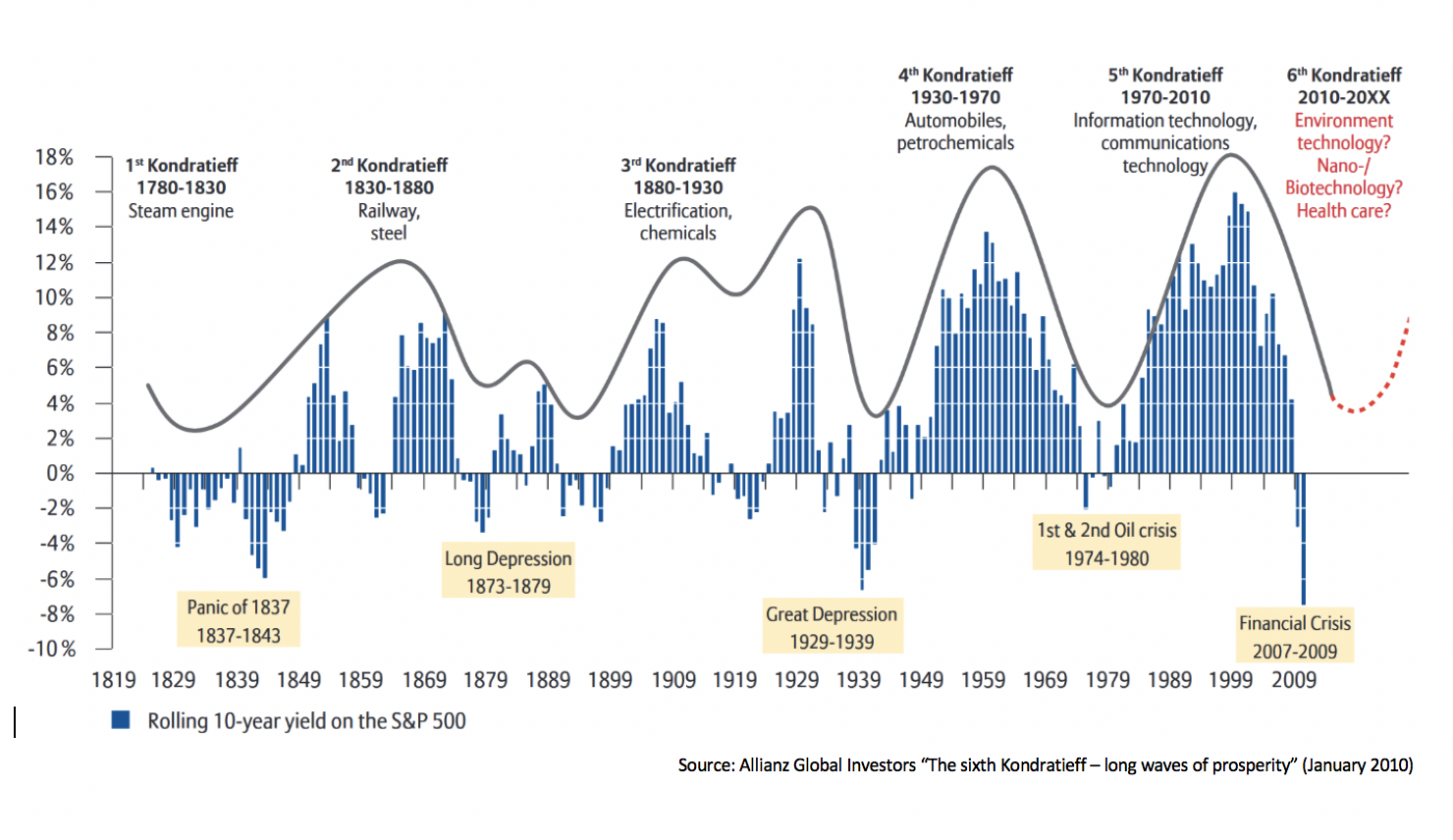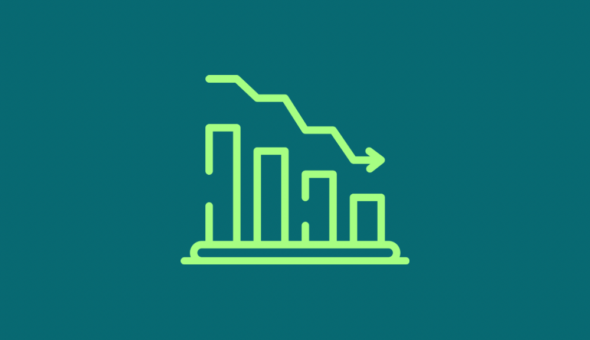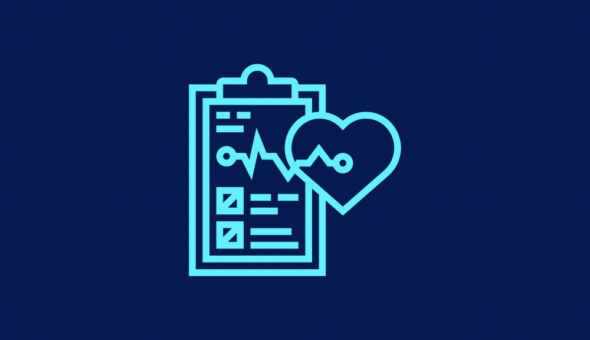Mark Hepworth is a multidisciplinary economist and entrepreneur whose international career spans academia, public policy and business consultancy. He leads The Good Economy's research and policy work on inclusive and sustainable development.
Talk of "building back better" after the economic shock of COVID-19 is everywhere. Co-founder Mark Hepworth dusts off his 30 year-old notes on maverick Russian economist Nikolai Kondratieff to offer insights into what a new economic wave could look like.
Kondratieff Waves describe 40-60 year ‘boom and bust’ economic cycles in capitalist development. They were ‘discovered’ by Russian economist Nikolai Kondratieff in the 1920s. He related the macroeconomic performance of the US, England, France and Germany between 1790 and 1920 to the movement of commodity prices and production, explaining these cycles by changes in technology, geopolitics and gold prices.
In 1942, Joseph Schumpeter published Capitalism, Socialism and Democracy in which he introduced innovation drivers into Kondratieff’s analytical framework. His version of Kondratieff Waves driven by radical innovations and ‘forces of creative destruction’ holds sway today. Kondratieff’s position that capitalist nations were not on an inevitable path to destruction was anathema to Stalinist authorities. He was executed by a firing squad in 1938.
Each Kondratieff cycle is hypothesised to have four seasons: Spring (boom), Summer (expansion), Autumn (stagnation) and Winter: “Economy in the throes of a debilitating depression that tears the social fabric of society, as the gulf between the dwindling number of "haves" and the expanding number of "have-nots" increases dramatically.” Adherents of Kondratieff analysis say we are in the Winter phase of the 5th Kondratieff.
Kondratieff and COVID-19
Kondratieff Wave theory, with its attention to history and society, sits outside mainstream economics. It is used by academics, investors and governments to understand how periods of heightened uncertainty or crisis relate to long-term economic and social trends. The COVID-19 crisis has increased interest in Kondratieff Waves – a notable example is Vincent Carpentier’s work on the socially divisive and polarising nature of COVID-19.
Locked in and zoomed out, I have been revisiting the books and papers I wrote on the geography of the ICT Revolution during the 1980s and 1990s. This was the time of the Spring and Summer seasons of the 5th Kondratieff, when my focus was on place-based ICT policies for inclusive growth and green growth.
The COVID-19 crisis engulfed the world at the cusp of the 5th and 6th Kondratieff Waves. It is the Winter season of the 5th Kondratieff - a depressing time of economic slow-down, entrenched social inequality, political instability and imminent ecological catastrophe. But it is also the Spring season of the 6th Kondratieff – a time of economic renewal and mass flourishing, driven by innovations in biotechnology, the environment, the ‘Internet of Things’ (IOT) and psycho-social health care systems. The UK, with the rest of the world, is hypothesised to be moving from globalisation and ICT to sustainability and IOT – a paradigm shift into the ‘Green Age’?

Back to the future
Back in 1992, I regularly debated the decentralising, equalising and ‘greening’ potential of the ICT Revolution – the 5th Kondratieff Wave. Today, we know the opposite happened: market power became more concentrated in large corporations (including new digital giants); London increased its economic leadership over the rest of the country; and PM2.5 air pollution has breached legal safety limits in most UK cities. The 5th Kondratieff has clearly not delivered on inclusive growth or green growth.
I attribute this failure to top-down policies that have ignored the importance of place and decentralisation – as I wrote about in an article called 'Place Matters’ for Green Futures magazine back in April 2001. The positive shock value of COVID-19 is that it has simultaneously revealed the failures of the 5th Kondratieff, while encouraging us to search out the 6th Kondratieff Wave.
It is interesting to note, for example, that the experienced geography of the COVID-19 crisis is consistent with the hypothesised geography of the 6th Kondratieff, which researchers at the INSEAD business school believe will be characterised by ‘an extreme geographical dispersion due to the optimisation of telecommunications’. Dispersion and decentralisation mean different things, but both are of relevance in looking ahead. The surge of teleworking in the lockdown is a good place to look through the keyhole into the future.
No place like home
Before the COVID-19 lockdown, 7% of the UK labour force was teleworking from home These teleworkers were predominantly higher-paid male professional and managerial staff employed by private companies (Labour Force Survey data). The lockdown has boosted this headline figure to 50%, partly because employers have been forced to extend home-based teleworking as a flexible work option to lower-paid female office support staff. In effect, the COVID-19 crisis has demonstrated that teleworking can be used to enhance occupational and gender-based equality in the workplaces of knowledge-intensive companies and sectors.
However, in sectors of the economy where work requires personal contact – notably, retail, leisure and hospitality - teleworking through the lockdown has not been an option. Without recourse to teleworking, households and communities dependent on these employment sectors have borne the brunt of the COVID-19 crisis – unemployment, the insecurities of temporary furloughing and a cliff-edge fall in personal, family and social well-being.
In effect, the COVID-19 crisis is a fundamental set-back to inclusive growth policies underway all over the UK. At the same time, it underlines the need to strengthen these place-based policies through new long-term partnerships with responsible businesses and impact investors. This is the focus of the Good Economy’s work, including its new place-based impact investing collaboration.
Teleworking involves a dual shift from physical to virtual mobility and from central to remote workspace. As such, a permanent scaling up of teleworking (e.g. two-thirds of City traders want to work from home one day a week after the COVID-19 crisis) increases risk in the bricks-and-mortar economy of commercial property and infrastructure – important asset classes for global investors. The business and property press is awash with ‘downsizing’ news and thought pieces on the office of the future. I was embroiled in this during the 1990/2 white collar recession.
The black swan and the city
But today’s context is new and different. COVID-19 is a Black Swan event arriving at a time when the UK economy has been weakened by a 20 year slowdown in productivity growth and the uncertainties of Brexit. We are faced by a perfect storm, which could encourage swathes of businesses to up anchor – to downsize and/or relocate their office operations regardless of lease and staff retention issues.
We should then surmise the future development paths of UK cities. COVID-19 may turn out to be a ‘leveller’ if downsizing and relocating go hand in hand, and large companies and government departments move to decentralise more and better jobs from London to the North, the Midlands and other regions. We don’t want them to go abroad. Should this happen at scale, we could see an end to the North-South Divide at long last, resulting in a 3-4% increase in UK economic growth and a major uplift in the North’s ‘left behind’ economies and communities. The OECD has shown that in order to enhance productivity in 11 core cities outside London, the UK must become less centralised, less regionally divided, and more locally invested. COVID-19 may be the catalyst we need for changing this geo-economic landscape.
Within cities, freed up office and retail space creates opportunities to advance the circular economy paradigm – a key area of 6th Kondratieff innovation. This space can be re-purposed for socially useful activities, including affordable housing, discounted retail space, community services, and co-working space for teleworkers and SMEs. This would mean a small hit for FTSE corporates and global investors who own much of the UK’s commercial and retail property but a big hit for local SMEs and local communities. The Good Economy is working with a number of investor clients in this area. This ‘small-big’ principle of shared value impact creation can sharpen the focus of place-based policy and investment.
Further, a widely-based permanent rise in teleworking would have the effect of partially displacing consumer demand and business networks from the central city to local town centres. American urban economist William Alonso called this ‘borrowing size’ – a small loss to the businesses located in the central city, but a big gain for local businesses in town centres, through multiplier and agglomeration effects. This ‘small-big’ principle should guide town centre modernisation policy and investment – a focus of Government place-based levelling-up policies.
The 6th Kondratieff frontline
We need to decentralise and plan ahead for the 6th Kondratieff. The COVID-19 frontline - Our NHS, Our Local Government and Our Universities– should also be the 6th Kondratieff ‘frontline’. These are its backbone.
Local authorities already play a key implementation role in areas of 6th Kondratieff innovation – such as health, renewable energy, climate change. Universities, as leaders of local industrial strategies, can invent 6th wave technologies but these only become innovations that create economic and social impact through implementation and service delivery. The 6th Kondratieff must be grounded in real places for it to create impact and value. Local government is best-placed to ensure everyone benefits from innovation-driven impact creation.
COVID-19 has led us to appreciate “Our NHS”, having neglected it for two decades. Given health care innovation is a 6th Kondratieff driver, long-term investing in ‘Our NHS’ makes sense economically and socially. The NHS is England’s biggest employer and a significant economic force in local communities through procurement and spending power, workforce and training and buildings and land. Strategic investment in the NHS is driving place-based inclusive growth in Greater Manchester, Birmingham and Preston. We should strengthen our NHS, our local government and our universities and incentivise them to act as a national backbone for 6th Kondratieff innovation aimed at making inclusive and sustainable development a reality across the UK.
The environmental impacts of the COVID-19 lockdown are stunning to behold. NO2 air pollution levels in cities have dropped by 60% due to the ‘disappearance’ of road traffic. We don’t want this to become a green mirage, but a powerful inspiration for climate change campaigns, policies, innovations and green entrepreneurship. We have to act fast. What paralyses action is the perception that climate change is gradual and far off – unlike COVID-19. “The Science” saw a catastrophic pandemic on the horizon, just as it sees climate change coming. If we don’t act now, the 6th Kondratieff could come to a grinding halt in ‘2050’.
Frank Snowden’s book Epidemics and Society suggests the COVID-19 crisis will put the UK on a different historical course. This blog shares some of The Good Economy’s own thoughts about this future course. The COVID-19 crisis should be a time for experimentation. Kondratieff Wave analysis is a good tool for that purpose.
This article was originally published on The Good Economy’s website and on Medium on 2 June 2020 .
-
Are you a decision-maker in government, industry or the third sector responding to the coronavirus crisis? Apply now to our virtual Policy Fellowship Programme for access to University of Bath research and expertise. Learn more.
All articles posted on this blog give the views of the author(s), and not the position of the IPR, nor of the University of Bath.
Responses





Thanks, Mark. We need an optimismistic outlook. Have forwarded to others.
I just wish to add, please consider 1) after the bust, comes the war, such as is increasingly being borne out 2) the COVID debacle is ~ of course ~ artificial, such as was the "Spanish Flu of 1918." Please don't ignore the inevitable genocidal policies, covert, during the bust phase, and overt, during the war phase. Thank you.